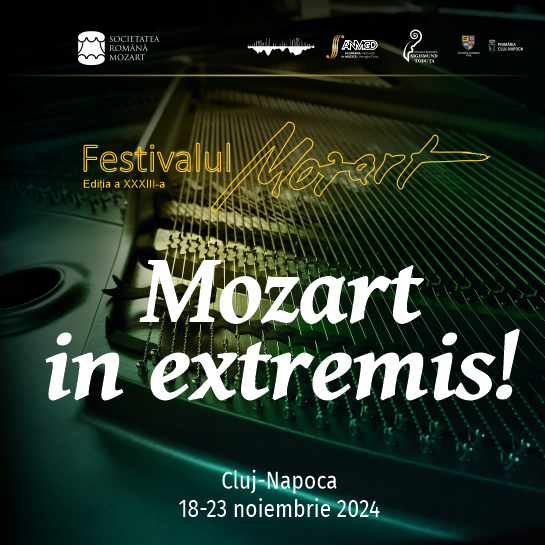
Luni, 18 noiembrie, ora 19.00
Sala Studio a Academiei Naționale de Muzică „Gheorghe Dima”
Mozart Juvenorum
Concert cameral susținut de elevi ai Colegiului de Muzică „Sigismund Toduță”
Lucrări de W.A. Mozart
Lansare de carte: Francisc László. Studii mozartiene III
Marţi, 19 noiembrie, ora 9.30 și 11.00
Auditorium Maximum
Concert Educativ pentru copii
Muzicanții din Bremen
Orchestra Regală de Tineret a Filarmonicii de Stat „Transilvania”
Dirijor: Dalma Toadere
Marţi, 19 noiembrie, ora 19.00
Sala Studio a Academiei Naționale de Muzică „Gheorghe Dima”
Contraste
Recital de pian și fortepiano
Aurelia Vișovan
W.A. Mozart: Sonata în Sol major, KV 283
G. Enescu: Suita a III-a, op. 18
W.A. Mozart: Variațiuni Unser dummer Pöbel meint, KV 455
Miercuri, 20 noiembrie, ora 10.00
Sala Studio a Academiei Naționale de Muzică „Gheorghe Dima”
Curs de măiestrie – pian și muzică de cameră
Aurelia Vișovan
Hochschule für Musik Nürnberg
Joi, 21 noiembrie, ora 13.00
Sala festivă a Colegiului de muzică „Sigismund Toduță”
Simpozion Internațional
Connecting with Mozart
Keynote speaker: Robert D. Levin
Link Zoom:
https://us05web.zoom.us/j/88309687130?pwd=VBJtNewUILJoulSDxDsQXiWwzhBIar.1
Meeting ID: 883 0968 7130
Vineri, 22 noiembrie, ora 19.00
Auditorium Maximum
Concert simfonic
Orchestra Filarmonicii de Stat „Transilvania”
Dirijor: Michal Nesterowicz
Solist: Can Çakmur – pian
C. Saint-Saëns: Concertul nr. 5, în Fa major, op. 103 pentru pian și orchestră
W.A. Mozart: Simfonia nr. 41, în Do major, KV 551 Jupiter
Sâmbătă, 23 noiembrie, ora 10.00
Sala Studio a Academiei Naționale de Muzică „Gheorghe Dima”
Curs de măiestrie – pian și muzică de cameră
Can Çakmur
Trinity Laban Conservatoire of Music and Dance, London